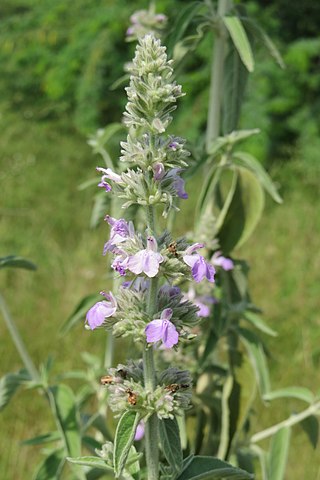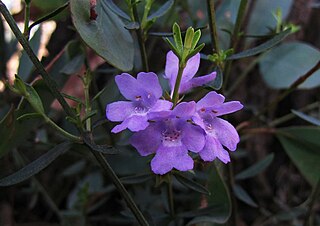
Stachys is a genus of plants, one of the largest in the mint family Lamiaceae. Estimates of the number of species vary from about 300, to about 450. Stachys is in the subfamily Lamioideae and its type species is Stachys sylvatica. The precise extent of the genus and its relationship to other genera in the subfamily are poorly known.

Galeopsis tetrahit, the common hemp-nettle or brittlestem hempnettle, is a flowering plant in the family Lamiaceae, native to Europe and northwestern Asia.

Stachys byzantina, the lamb's-ear or woolly hedgenettle, is a species of flowering plant in the mint family Lamiaceae, native to Armenia, Iran, and Turkey. It is cultivated throughout much of the temperate world as an ornamental plant, and is naturalised in some locations as an escapee from gardens. Plants are very often found under the synonym Stachys lanata or Stachys olympica.
This page provides a glossary of plant morphology. Botanists and other biologists who study plant morphology use a number of different terms to classify and identify plant organs and parts that can be observed using no more than a handheld magnifying lens. This page provides help in understanding the numerous other pages describing plants by their various taxa. The accompanying page—Plant morphology—provides an overview of the science of the external form of plants. There is also an alphabetical list: Glossary of botanical terms. In contrast, this page deals with botanical terms in a systematic manner, with some illustrations, and organized by plant anatomy and function in plant physiology.

Galeopsis bifida is an annual plant native to Europe and Asia but now found in Canada and the northeastern, midwestern parts of the United States. It has many common names such as bifid hemp-nettle, split-lip hemp-nettle, common hemp-nettle, and large-flowered hemp-nettle. The genus name means weasel-like, referring to the corolla of the flower. It is often confused with other species of Lamiaceae such as Mentha arvensis, Dracocephalum parviflorum and Stachys pilosa.

Stachys arvensis is a species of flowering plant in the mint family known by the common names field woundwort and staggerweed. It is native to Europe, Western Asia, and North Africa. It is known on other continents as an introduced species and widespread weed.

Anisomeles malabarica, more commonly known as the Malabar catmint, is a species of herbaceous shrub in the family Lamiaceae. It is native to tropical and subtropical regions of India, and Sri Lanka, but can also be found in Malaysia, Bangladesh, Myanmar, Bismarck Archipelago, Mauritius, Andaman Islands and Réunion.

Stachys recta, commonly known as stiff hedgenettle or perennial yellow-woundwort, is herbaceous perennial plant of the family Lamiaceae.

Leucas aspera is a plant species within the genus Leucas and the family Lamiaceae. Although the species has many different common names depending on the region in which it is located, it is most commonly known as Thumbai or Thumba. Found throughout India, it is known for its various uses in the fields of medicine and agriculture.

Westringia crassifolia, commonly known as whipstick westringia, is a flowering plant in the family Lamiaceae and is endemic to Victoria, Australia. It is a rare shrub with narrow leaves and lavender-purple or pink flowers in spring.

Pseudodictamnus acetabulosus, the Greek horehound, is a species of flowering plant in the family Lamiaceae, native to south-eastern Greece, Crete, and western Turkey. It is a compact, evergreen subshrub growing to 0.5 metres (20 in). Upright woolly grey shoots turn to rounded grey-green leaves, bearing whorls of small pink flowers with funnel-shaped green calyces in late summer and autumn. It is tolerant of poor soil and drought, and often used in cultivation as groundcover.

Hemiphora is a genus of five species of flowering plants in the mint family, Lamiaceae and is endemic to Western Australia. Plants in this genus are woolly shrubs with warty, hairy leaves and with five petals joined to form a tube-shaped flower with four stamens. These species are similar to those in the genus Chloanthes in that the base of the leaves extends down the stem. They differ from Chloanthes, in that the leaves only extend a short distance down the stem.

Quoya verbascina, commonly known as golden bush, is a flowering plant in the mint family Lamiaceae and is endemic to Western Australia. It is an erect shrub with its branches and leaves densely covered with woolly hairs. The leaves are often oblong but very variable in shape and the flowers are pinkish-white with pink spots inside and are surrounded by yellow woolly sepals.

Stachys hispida, commonly known as hispid hedgenettle, is a species of flowering plant in the mint family (Lamiaceae). It is native to eastern North America, where it is found in Canada and the United States. Its natural habitat is in moist areas, such as alluvial banks, bottomland forests, and wet meadows.

Galeopsis pubescens, also known as the hairy and downy hempnettle, is a herbaceous annual plant species in the family Lamiaceae, that can be found growing in various European countries.

Westringia brevifolia Benth., commonly referred to as Greater Shortleaf Westringia is member of the Lamiaceae family, subfamily, Prosterantheroideae and one of four Westringia species native Tasmania, Australia. This evergreen shrub somewhat resembles rosemary and is similar in appearance to another Tasmanian species W. rigida, but can be distinguished by its shorter calyx lobes

Stachys buttleri is a species of flowering plant in the family Lamiaceae endemic to Turkey growing on a single rock face in Antalya.

Stachys pinardii is a species of flowering plant in the family Lamiaceae endemic to the Antalya region of Turkey.

Stachys antalyensis is a species of flowering plant in the family Lamiaceae endemic to the Antalya region of Turkey.

Stachys aleurites is a species of flowering plant in the family Lamiaceae endemic to the Antalya region of Turkey. It was first published in 1848.
































